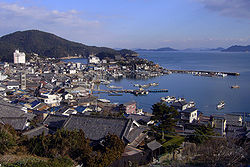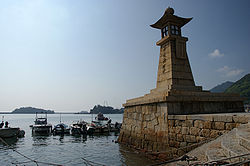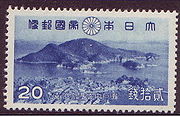
Tomonoura
Encyclopedia



Fukuyama, Hiroshima
is a city located on the Ashida River in Hiroshima Prefecture, Japan.As of January 31, 2010, the city has an estimated population of 465,238 and a population density of 898.02 persons per km². The total area is 461.23 km². After Hiroshima City, it is the largest city in Hiroshima Prefecture...
, Hiroshima Prefecture
Hiroshima Prefecture
is a prefecture of Japan located in the Chūgoku region on Honshu island. The capital is the city of Hiroshima.- History :The area around Hiroshima was formerly divided into Bingo Province and Aki Province. This location has been a center of trade and culture since the beginning of Japan's recorded...
, Japan
Japan
Japan is an island nation in East Asia. Located in the Pacific Ocean, it lies to the east of the Sea of Japan, China, North Korea, South Korea and Russia, stretching from the Sea of Okhotsk in the north to the East China Sea and Taiwan in the south...
. It is located on the southern point of the Numakuma Peninsula, and has been a prosperous port and bay area since ancient times. Its unique circular harbor shape was preserved even when modern port facilities were introduced. Tomonoura is located within and is part of Setonaikai National Park
Setonaikai National Park
is a national park that covers the entire expanse of Japan's Inland Sea. It was designated a national park in 1934. It contains about 3,000 islands. The well-known Itsukushima Island lies within the park.-External links:...
. It was listed as one of the top 100 scenic municipalities in Japan, and as one of the top 100 historical natural features in Japan in 2007.
Overview
Tomonoura is located 14-kilometer south from Fukuyama Station. There are many historical temples and shrines around Tomonoura, and the area is famous for fishing.History
- 8 poetriesPoetryPoetry is a form of literary art in which language is used for its aesthetic and evocative qualities in addition to, or in lieu of, its apparent meaning...
about Tomonoura were written on the Japanese oldest collection of poems Man'yōshū in Tenpyō-hōjiTenpyo-hojiwas a after Tenpyō-shōhō and before Tenpyō-jingo. This period spanned the years from August 757 through January 765. The reigning empress was .-Change of era:* 757 ): The new era name was created to mark an event or series of events...
era. - Jyoganji Temple was established by SaichōSaichowas a Japanese Buddhist monk credited with founding the Tendai school in Japan, based around the Chinese Tiantai tradition he was exposed to during his trip to China beginning in 804. He founded the temple and headquarters of Tendai at Enryaku-ji on Mt. Hiei near Kyoto. He is also said to have...
, Ioji Temple was established by KūkaiKukaiKūkai , also known posthumously as , 774–835, was a Japanese monk, civil servant, scholar, poet, and artist, founder of the Shingon or "True Word" school of Buddhism. Shingon followers usually refer to him by the honorific titles of and ....
in Heian periodHeian periodThe is the last division of classical Japanese history, running from 794 to 1185. The period is named after the capital city of Heian-kyō, or modern Kyōto. It is the period in Japanese history when Buddhism, Taoism and other Chinese influences were at their height...
. - Nunakuma Shrine, the main shrine of Yasaka ShrineYasaka Shrine', once called , is a Shinto shrine in the Gion District of Kyoto, Japan. Situated at the east end of Shijō-dōri , the shrine includes several buildings, including gates, a main hall and a stage.-History:...
was established in Heian period. - After the Battle of TatarahamaBattle of Tatarahama (1336)The 1336 battle of Tatarahama was one of many battles constituting the Nanboku-chō Wars in Japan, in which two rival Imperial Courts battled for legitimacy and control of the country...
, a memorial writing for Nitta YoshisadaNitta Yoshisadawas the head of the Nitta family in the early fourteenth century, and supported the Southern Court of Emperor Go-Daigo in the Nanboku-chō period, capturing Kamakura from the Hōjō clan in 1333....
was given to Ashikaga TakaujiAshikaga Takaujiwas the founder and first shogun of the Ashikaga shogunate. His rule began in 1338, beginning the Muromachi period of Japan, and ended with his death in 1358...
from Emperor KōgonEmperor KōgonEmperor Kōgon was the 1st of Ashikaga Pretenders during the Period of the Northern and Southern Courts in Japan...
in Tomonoura in 1336. - The Five-storey pagodas of Jyoganji Temple was lost during the Battle of Tomo between Northern Court and Southern CourtSouthern CourtThe were a set of four emperors whose legitimate claims were usurped during the Nanboku-chō period spanning from 1336 through 1392. In spite of the legitimacy of its claims to the throne, the Southern Court was permanently replaced in 1392 by the illegitimate Northern Court.-Nanboku-chō overview:...
in Nanboku-chō period. - The former Tomo Castle was built by Mōri clanMori clanThe Mōri clan was a family of daimyō, descended from Ōe no Hiromoto and established themselves in Aki Province. Their name was derived from a shōen in Mōri, Aikō District, Sagami Province. The generation of Hiromoto began to name themselves Mōri.After the Jōkyū War, Mōri was appointed to the jitō...
in Sengoku periodSengoku periodThe or Warring States period in Japanese history was a time of social upheaval, political intrigue, and nearly constant military conflict that lasted roughly from the middle of the 15th century to the beginning of the 17th century. The name "Sengoku" was adopted by Japanese historians in reference...
. - After Ashikaga YoshiakiAshikaga Yoshiakiwas the 15th shogun of the Ashikaga shogunate in Japan who reigned from 1568 to 1573. His father, Ashikaga Yoshiharu was the twelfth shogun, and his brother, Ashikaga Yoshiteru was the thirteenth shogun....
was banished from Kyoto by Oda NobunagaOda Nobunagawas the initiator of the unification of Japan under the shogunate in the late 16th century, which ruled Japan until the Meiji Restoration in 1868. He was also a major daimyo during the Sengoku period of Japanese history. His opus was continued, completed and finalized by his successors Toyotomi...
, Ashikaga formed Tomo Bakufu with Ise clan, Ueno clan and Odachi clan with Mōri clan's support, to against Oda. - Fukushima MasanoriFukushima Masanoriwas a Japanese daimyo of the late Sengoku Period to early Edo Period who served as lord of the Hiroshima Domain. A retainer of Toyotomi Hideyoshi, he fought in the battle of Shizugatake in 1583, and soon became known as one of Seven Spears of Shizugatake which also included Katō Kiyomasa and...
of Bingo ProvinceBingo Provincewas a province of Japan on the Inland Sea side of western Honshū, comprising what is today the eastern part of Hiroshima Prefecture. It was sometimes called , with Bizen and Bitchu Provinces. Bingo bordered Bitchū, Hōki, Izumo, Iwami, and Aki Provinces....
started rebuilding of Tomo Castle in Edo periodEdo periodThe , or , is a division of Japanese history which was ruled by the shoguns of the Tokugawa family, running from 1603 to 1868. The political entity of this period was the Tokugawa shogunate....
. (construction was disturbed by Tokugawa IeyasuTokugawa Ieyasuwas the founder and first shogun of the Tokugawa shogunate of Japan , which ruled from the Battle of Sekigahara in 1600 until the Meiji Restoration in 1868. Ieyasu seized power in 1600, received appointment as shogun in 1603, abdicated from office in 1605, but...
.) - Mizuno KatsushigeMizuno Katsushigewas a daimyo during the late Sengoku Period of Feudal Japan.The son of Mizuno Tadashige, he had in his younger years served Sasa Narimasa, for whom he fought in Toyotomi Hideyoshi's Kyushu Campaign in 1587, Kato Kiyomasa, Konishi Yukinaga and Tokugawa Ieyasu, for whom he fought in in the Siege of...
of Fukuyama DomainFukuyama DomainThe ' was a Japanese domain of the Edo period, located in Bingo and Bitchū provinces.-List of lords:*Mizuno clan, 1619-1698 #Katsunari#Katsutoshi#Katsusada#Katsutane#Katsumine*Tenryō, 1698-1700...
was opened the government office at the site of Tomo Castle. - The governor of Joseon DynastyJoseon DynastyJoseon , was a Korean state founded by Taejo Yi Seong-gye that lasted for approximately five centuries. It was founded in the aftermath of the overthrow of the Goryeo at what is today the city of Kaesong. Early on, Korea was retitled and the capital was relocated to modern-day Seoul...
with Joseon Tongsinsa praised the prospect from Fukizenji Temple as the most beautiful in 1711. - Tomonoura was the site of the sinking of the Irohamaru, the ship of Sakamoto Ryoma.
- Tomo railway service between Tomo station and Fukuyama Station was started in 1913. (closed in 1954)
- The Setonaikai National ParkSetonaikai National Parkis a national park that covers the entire expanse of Japan's Inland Sea. It was designated a national park in 1934. It contains about 3,000 islands. The well-known Itsukushima Island lies within the park.-External links:...
was founded, including Tomo, Suisenjima and Bentenjima islands, with Abuto Kannon on March 16, 1934.
Bridge construction plan
The local government had a plan to build a bridge over the scenic harbor for a bypass road. The plan has caused much conflict with the local community concerned about the historical harbor. The plan has now been overturned by the Hiroshima District Court. The planned construction also became the reason why the town was included in the World Monuments Watch by the World Monuments FundWorld Monuments Fund
World Monuments Fund is a private, international, non-profit organization dedicated to the preservation of historic architecture and cultural heritage sites around the world through fieldwork, advocacy, grantmaking, education, and training....
in 2002 and 2004. The organization subsequently helped restore a historic merchant house in the town with financial support from American Express
American Express
American Express Company or AmEx, is an American multinational financial services corporation headquartered in Three World Financial Center, Manhattan, New York City, New York, United States. Founded in 1850, it is one of the 30 components of the Dow Jones Industrial Average. The company is best...
. The 19th century residence, known as Uoya-Manzo, has since become an information center and guesthouse for visitors.
Music
Haru no UmiHaru no Umi
Haru no Umi is a Meiji shinkyoku piece for koto and shakuhachi composed in 1929 by Michio Miyagi. It is Miyagi's best known piece and one of the most famous for the koto and shakuhachi instruments....
, composed by Michio Miyagi
Michio Miyagi
was a Japanese musician, famous for his koto playing.He was born in Kobe. He lost his sight in 1902, when he was 8 years old, and started his study in koto under the guidance of Nakajima Kengyo II, dedicating the rest of his life to the instrument. In 1907 he moved with his family to Incheon, in...
- Koto
Koto (musical instrument)
The koto is a traditional Japanese stringed musical instrument, similar to the Chinese guzheng, the Mongolian yatga, the Korean gayageum and the Vietnamese đàn tranh. The koto is the national instrument of Japan. Koto are about length, and made from kiri wood...
music - (1929)
Books
Tomonotsu Chakaiki by Masuji IbuseMasuji Ibuse
was a Japanese author.-Life and work:Ibuse was born in 1898 to a landowning family in the village of Kamo which is now part of Fukuyama, Hiroshima.At the age of 19 he started studying at Waseda University in Tokyo...
- Fiction
Fiction
Fiction is the form of any narrative or informative work that deals, in part or in whole, with information or events that are not factual, but rather, imaginary—that is, invented by the author. Although fiction describes a major branch of literary work, it may also refer to theatrical,...
about the life of Toyotomi Hideyoshi
Toyotomi Hideyoshi
was a daimyo warrior, general and politician of the Sengoku period. He unified the political factions of Japan. He succeeded his former liege lord, Oda Nobunaga, and brought an end to the Sengoku period. The period of his rule is often called the Momoyama period, named after Hideyoshi's castle...
- (1986)
鞆の浦殺人事件 (Murder in Tomonoura) by Yasuo Uchida - Detective fiction
Detective fiction
Detective fiction is a sub-genre of crime fiction and mystery fiction in which an investigator , either professional or amateur, investigates a crime, often murder.-In ancient literature:...
- (1988)
Films
- 白椿 (White camelliaCamelliaCamellia, the camellias, is a genus of flowering plants in the family Theaceae. They are found in eastern and southern Asia, from the Himalaya east to Korea and Indonesia. There are 100–250 described species, with some controversy over the exact number...
), directed by Masatoshi Akihara, acted by Hiroko HatanoHiroko Hatanois a Japanese model and actress. As an 18-year-old, she made her model debut on Japanese fashion magazine JJ in March 1994. She was one of the top models for the magazine until 2001, when she temporarily quit modeling to concentrate on her acting career...
- a story of a family in Tomo - (2007) (original story written by Yumeno KyūsakuYumeno Kyusakuwas the pen name of the early Shōwa period Japanese author Sugiyama Taidō. The pen name literally means "a person who always dreams." He wrote detective novels and is known for his avant-gardism and his surrealistic, wildly imaginative and fantastic, even bizarre narratives...
) - 崖の上のポニョ(Ponyo), directed by Hayao MiyazakiHayao Miyazakiis a Japanese manga artist and prominent film director and animator of many popular anime feature films. Through a career that has spanned nearly fifty years, Miyazaki has attained international acclaim as a maker of animated feature films and, along with Isao Takahata, co-founded Studio Ghibli,...
- (2008) (Miyazaki rented a house in Tomonoura, in which he stayed for two months in 2005)

